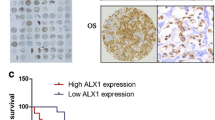Abstract
Osteosarcoma is the common primary bone malignancy in children and young adults in Eastern countries. Resistance to ionizing radiation (IR) or drugs is an underlying mechanism contributing to the failure of therapy in these patients. Rad51 is the key protein of DNA homologous recombination repair. Although high expression of Rad51 is associated with enhanced resistance to DNA damage induced by chemicals and/or ionizing radiation, the relevance of Rad51 expression in osteosarcoma and its relationship with IR sensitivity and chemo-resistance is not well understood. In this study, we elucidated the possibility of using Rad51 in the treatment of human osteosarcoma in vitro. Changes in chemo- and radiation sensitivity in cultured osteosarcoma cells occurred after suppression of Rad51 expression, using a plasmid vector-mediated short hairpin RNA (shRNA) expression system. The suppression of Rad51 correlated with cell cycle arrest in the G2 phase and inhibited tumor cell proliferation. Our results suggest that Rad51 expression levels might play an important role in radiation- and chemo-sensitivity of human osteosarcoma.






Similar content being viewed by others
Reference:
Lee JA, et al. Relative tumor burden predicts metastasis-free survival in pediatric osteosarcoma. Pediatr Blood Cancer. 2008;50(2):195–200.
Longhi A, et al. Primary bone osteosarcoma in the pediatric age: state of the art. Cancer Treat Rev. 2006;32(6):423–36.
O’Driscoll L. Mechanisms of drug sensitivity and resistance in cancer. Curr Cancer Drug Targets. 2009;9(3):250–1.
Kubista B, et al. Anticancer effects of zoledronic acid against human osteosarcoma cells. J Orthop Res. 2006;24(6):1145–52.
van Gent DC, Hoeijmakers JH, Kanaar R. Chromosomal stability and the DNA double-stranded break connection. Nat Rev Genet. 2001;2(3):196–206.
Raderschall E, et al. Elevated levels of Rad51 recombination protein in tumor cells. Cancer Res. 2002;62(1):219–25.
Vispe S, et al. Overexpression of Rad51 protein stimulates homologous recombination and increases resistance of mammalian cells to ionizing radiation. Nucleic Acids Res. 1998;26(12):2859–64.
Slupianek A, et al. BCR/ABL regulates mammalian RecA homologs, resulting in drug resistance. Mol Cell. 2001;8(4):795–806.
Sak A, et al. Targeting of Rad51-dependent homologous recombination: implications for the radiation sensitivity of human lung cancer cell lines. Br J Cancer. 2005;92(6):1089–97.
Saydam O, et al. HSV-1 amplicon-mediated post-transcriptional inhibition of Rad51 sensitizes human glioma cells to ionizing radiation. Gene Ther. 2007;14(15):1143–51.
Hannay JA, et al. Rad51 overexpression contributes to chemoresistance in human soft tissue sarcoma cells: a role for p53/activator protein 2 transcriptional regulation. Mol Cancer Ther. 2007;6(5):1650–60.
Pawlik TM, Keyomarsi K. Role of cell cycle in mediating sensitivity to radiotherapy. Int J Radiat Oncol Biol Phys. 2004;59(4):928–42.
Russell JS, et al. Gleevec-mediated inhibition of Rad51 expression and enhancement of tumor cell radiosensitivity. Cancer Res. 2003;63(21):7377–83.
Brummelkamp TR, Bernards R, Agami R. Stable suppression of tumorigenicity by virus-mediated RNA interference. Cancer Cell. 2002;2(3):243–7.
Ko JC, et al. Involvement of Rad51 in cytotoxicity induced by epidermal growth factor receptor inhibitor (gefitinib, IressaR) and chemotherapeutic agents in human lung cancer cells. Carcinogenesis. 2008;29(7):1448–58.
Ishida T, et al. DIDS, a chemical compound that inhibits RAD51-mediated homologous pairing and strand exchange. Nucleic Acids Res. 2009;37(10):3367–76.
Ko JC, et al. Roles of MKK1/2-ERK1/2 and phosphoinositide 3-kinase-AKT signaling pathways in erlotinib-induced Rad51 suppression and cytotoxicity in human non-small cell lung cancer cells. Mol Cancer Res. 2009;7(8):1378–89.
Su YJ et al. Role of Rad51 downregulation and ERK1/2 inactivation in emodin and mitomycin C-induced synergistic cytotoxicity in human non-small cell lung cancer cells. Mol Pharmacol. 2010;77(4):633–43.
Ko JC, et al. Role of repair protein Rad51 in regulating the response to gefitinib in human non-small cell lung cancer cells. Mol Cancer Ther. 2008;7(11):3632–41.
Acknowledgments
We thank Prof Chunming Zhang for discussions and Dezhi Wang for technical assistance. This work was supported by the Exploration Foundation of the Institute of Radiation Medicine (ST0638) and the Talent Foundation of the Institute of Radiation Medicine (SR1001).
Author information
Authors and Affiliations
Corresponding author
Rights and permissions
About this article
Cite this article
Du, LQ., Wang, Y., Wang, H. et al. Knockdown of Rad51 expression induces radiation- and chemo-sensitivity in osteosarcoma cells. Med Oncol 28, 1481–1487 (2011). https://doi.org/10.1007/s12032-010-9605-1
Received:
Accepted:
Published:
Issue Date:
DOI: https://doi.org/10.1007/s12032-010-9605-1




